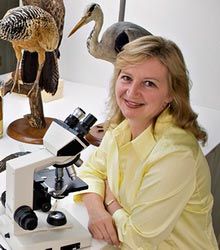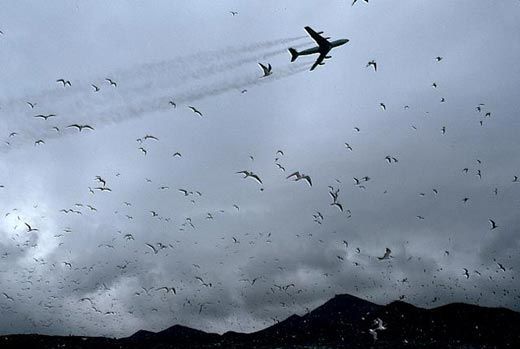The Perils of Bird-Plane Collisions
When airlines want to investigate dangerous bird strikes against planes, they turn to the head of the Smithsonian’s Feather Identification Lab
/https://tf-cmsv2-smithsonianmag-media.s3.amazonaws.com/filer/airplane-birds-631.jpg)
UPDATED: February 5, 2009
When US Airways Flight 1549 crash landed into the Hudson River in January, the plane suffered a “double bird strike,” according to audio tapes released by the FAA, forcing the pilot to glide the aircraft to safety. When a bird strikes a plane, identifying the species can provide valuable information. We spoke with Carla Dove, who heads up the Feather Identification Lab at the Smithsonian’s National Museum of Natural History, which has long had that important identification job.
When last the magazine last spoke with you, in 2004, you were working on a database of bird DNA. What is the status of that project?
That project was completed in 2006, and it was collaboration between the University of Guelph and the Smithsonian. [The goal of] that project was to barcode—take a little DNA snippet—of all of the birds of North America, 800 species or so. We completed that project using frozen bird tissue samples that we have here in our collection and that we borrowed from other museums. Now we have a known reference library for the bird species that occur in North America.
What will be the use of all that information?
We can take the pieces of snarge and the blood and tissue and everything that comes off of an aircraft after a bird strike and try to obtain DNA from that unknown sample. And once we do get a DNA sequence from that unknown sample, we now have a reference source to match up the unknown sample to. We can get a DNA match from some of these bird strikes that have very little material, that lack the feathers and whole feather material [that would more easily identify the species].
What advantage do you get from knowing the species of bird that hit a plane?
If we know what species of birds are causing the problem, causing damage to aircraft, then we can give that information to the airfields and they can do something to prevent that from happening [in the future]. Most of the time it’s habitat management. It could involve getting propane cannons, bird radar or all kinds of habitat mitigation. The first step is knowing what are the species causing a problem. Then once we know that we can work from there to avoid birds and aircraft collisions.
After the database, what’s the next step in your research?
The next step will probably be to get a better DNA resource for some of these larger birds that are causing problems. Often times we want to know how many birds went into the engine—was it multiple birds or just a single individual—and we can’t tell that with the DNA technology that we have now. We need to do more sophisticated work on the population genetics of birds, especially the larger birds, to figure out a more sophisticated way to identify individual birds. It’s kind of like DNA fingerprinting for people.
What has been the trend in bird strikes over the last few decades?
It’s very hard to say. I can tell you there has been a definite increase in the awareness and reporting. When I started working [on this], we would get 300 strikes per year to identify. And now, this past year, we got 4000 strikes. It’s not really that bird strikes are happening more often, it’s that people are now reporting them more frequently and they are aware that if we can determine the species of bird involved, they can do something to prevent the damage from happening. Because of the increased education and awareness and reporting, the bird strike caseload has increased.
The interesting thing about all of this right now is that in the past 25 years or so, large birds in North America have increased population-wise. If you think about it, you never used to see a Canada goose 20 years ago and now they’re everywhere. The same thing with birds like bald eagles and white pelicans. And so as these large birds increase population-wise and proportionally over time, there are more of them around. And there are more aircraft flying, and so the hazard is increasing. And that’s a tough one to deal with.
/https://tf-cmsv2-smithsonianmag-media.s3.amazonaws.com/accounts/headshot/Sarah-Zielinski-240.jpg)


/https://tf-cmsv2-smithsonianmag-media.s3.amazonaws.com/accounts/headshot/Sarah-Zielinski-240.jpg)